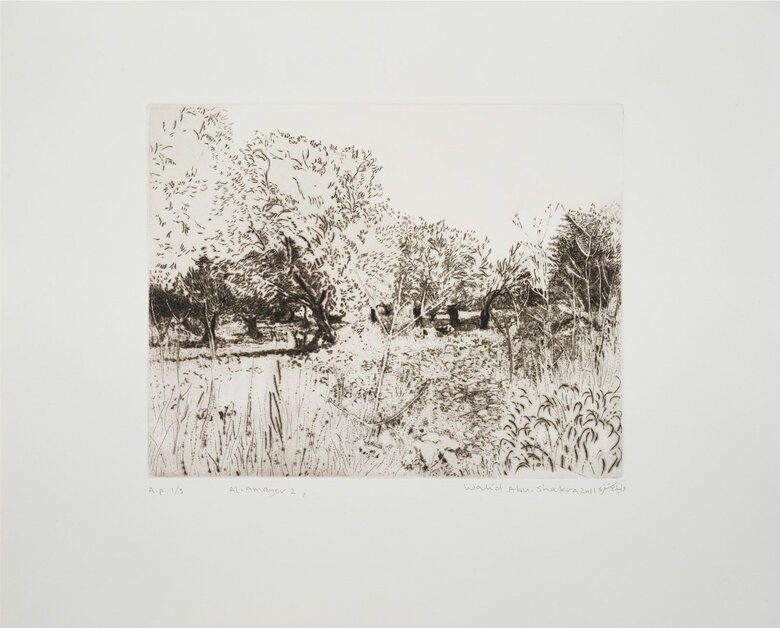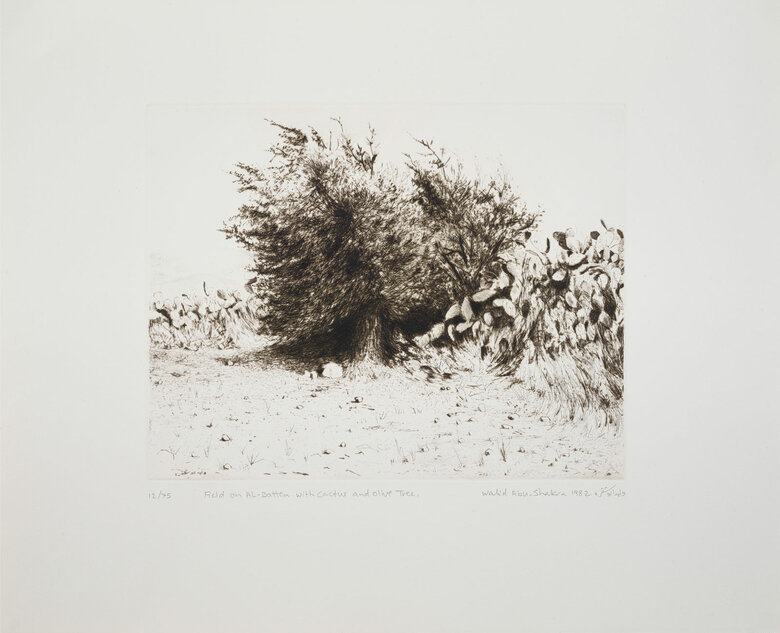Walid Abu Shakra was born in Umm El Fahem, Palestine, in 1946. He left school at the age of 16 to support his family, working several jobs in Jaffa and Hadera just to make ends meet. Shakra was...
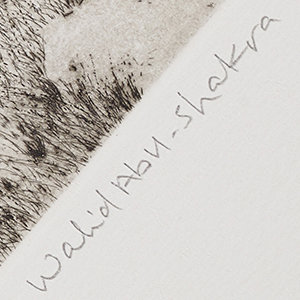

WALID ABU SHAKRA, Palestine (1946 - 2019)
Bio
Written by Wafa Roz
Walid Abu Shakra was born in Umm El Fahem, Palestine, in 1946. He left school at the age of 16 to support his family, working several jobs in Jaffa and Hadera just to make ends meet. Shakra was among the first generation of Palestinians to study in Israeli schools; in 1967, he studied at the Avni Institute of Art and Design, in Tel Aviv, under Yaakov Wechsler, Moshe Propes, Avshalom Okashi, Yehezkel Streichman, and others. In 1974, he moved to London, where he studied etching at Central Saint Martin’s College of Art and Design.
Abu Shakra faced numerous obstacles as a Palestinian student in an Israeli institution. At the Avni Institute, as elsewhere in the colonial state, classes were held only in Hebrew, and the curriculum was concerned solely with a Western cultural and artistic heritage. Despite these obstacles, Abu Shakra worked to celebrate and preserve Palestinian visual traditions in his work.
In light of the continuous expropriation of Palestinian land by the Israeli state, Abu Shakra built his artistic career around preserving this vanishing landscape in his monochromatic etchings and engravings. His works are intimate, some as small as an identity card, and feature details that connote his knowledge of and fondness for Palestine. The artist renders native flora with care and precision and titles his works with the Arabic place-names that the Israeli occupation has violently supplanted with Hebrew ones. The intimate works invite equally intimate relationships with their viewers: one imagines that a native villager could carry in his pocket a tiny drawing like a talisman, a piece of his hometown that is nowhere to be found on an Israeli map.
Abu Shakra’s works call attention to the erasure inherent in the Israeli colonial project, a goal apparent in his famous renderings of the cactus, or sabra. While the sabra was appropriated as an Israeli nationalist symbol after 1948, for Palestinians, it represented an eternal, resilient link to the land – and a stubborn refusal to leave it. Unlike his younger cousin Asim, Walid Abu Shakra did not depict the cactus as uprooted and contained in a flower pot, nor did he place it centrally in his works. Instead, the artist depicted the cacti in its native environment, where it had been used by Palestinian farmers for centuries to designate territorial boundaries. Though they appear to be straightforward landscapes, drawn from life, one wonders at the connotations of the sabra as a mark of land ownership. Perhaps this is another element of Abu Shakra’s quiet resistance to Israeli appropriation, staking a claim upon the sabra as upon the land it delineates.
In the mid-1980s, Abu Shakra’s artistic career was interrupted for nearly a quarter of a century when he devoted himself to Sufism and religious studies. In his 70s, he resumed working with prints and returned to his famed landscapes. The artist’s 2012 retrospective was held simultaneously at the Tel Aviv Museum of Art and his brother Said’s gallery in Umm El Fahem, enabling audiences from both sides of the colonial divide to see his work.
The artist died in London, 2019.
Sources
Boullata, Kamal, and John Berger. Palestinian art 1850-2005. London: SAQI, 2009.
Villarreal, Ignacio. A gaze at the watchman's post: A selection of prints by Walid Abu Shakra at the Tel Aviv Museum of Art. Accessed October 17, 2017. http://artdaily.com/news/52922/A-gaze-at-the-watchman-s-post--A-selection-of-prints-by-Walid-Abu-Shakra-at-the-Tel-Aviv-Museum-of-Art#.WeWs0ccvJBw.
אזולאי, אליערמון. "מחסוםכיסופים: ראיוןעםהאמןהפלסטיניולידאבושקרה." הארץ. January 06, 2012. Accessed October 17, 2017. https://www.haaretz.co.il/gallery/art/1.1610233.
Azoulay, Ellie Armon. "A new retrospective shows how far Palestinian art has come." Haaretz.com. January 14, 2012. Accessed October 17, 2017. https://www.haaretz.com/israel-news/culture/a-new-retrospective-shows-how-far-palestinian-art-has-come-1.407309.
CV
Selected Solo Exhibitions
2019
In Your Way, Retrospective exhibition, Umm el-Fahem Art Gallery, Occupied Palestine
2012
Mintarat Al-baten, Tel Aviv Museum of Art, Tel Aviv, Occupied Palestine
2011
Mintarat Al-baten, Umm el-Fahem Art Gallery, Occupied Palestine
Selected Group Exhibitions
2023
Spirit of Man, Spirit of Place, Mishkan Museum of Art / Museum of Art Ein Harod, Ein Harod, Occupied Palestine
2019
Intimate Terrains :Representations of a Disappearing Landscape, The Palestinian Museum, Birzeit, Occupied Palestine
2018
All in the Family: Family Legacy in Israeli Art, Senate Gallery, George Shrut Visitors Center, Ben-Gurion University of the Negev, Beer Sheva, Occupied Palestine
2017
House of Culture & Art,Nazareth, Occupied Palestine
Current Affairs, Tel Aviv Museum of Art, Occupied Palestine
2014
Umm El Fahem Art Gallery, Umm El Fahem, Occupied Palestine
2013
Log in Log Out, Beit Hagefen Gallery, Haifa, Occupied Palestine
2011
Artists' Choices – Susan Hiller: A Work in Progress, Israel Museum, Occupied Palestine
2008
Correspondence: Contemporary Arab Artists, Museum of Islamic Art, Jerusalem, Occupied Palestine
2007
Meetings Between Cultures, Israel, Oranim, Art Institute Gallery, Tivon, Occupied Palestine
2006
Winners of the Ministry of Education Prizes for Art and Design, Petach Tikvah Museum of Art, Petach Tikva, Occupied Palestine
International Seminar-Between Sderot and Tel aviv, Shenkar, School of Engineering & Design, Ramat Gan, Occupied Palestine
2001
Love at First Sight: The Vera and Arturo Schwarz Collection of Israeli Art, Israel Museum, Jerusalem, Occupied Palestine
2000
Life, Municipal Gallery, Kfar Saba, Occupied Palestine
1999
Abu Shakra - Personal Images, Kiryat Ha'Omanim Gallery, Tivon, Occupied Palestine
Givatayim Theatre, Givatayim, Occupied Palestine
1996
Um El Fahem Art Gallery, Um El Fahem, Occupied Palestine
1995
The Motif of the Cactus in Israeli Art, Tel Aviv Museum of Art, Helena Rubinstein Pavilion, Tel Aviv, Occupied Palestine
1992
Walid, Said and Farid Abu Shakra, Ephrat Gallery, Tel Aviv, Occupied Palestine
1986
Landscape and Nature: Contemporary Israeli Prints from the Collection of The Israel Museum,Jerusalem, High Court of Australia, Canberra, Australia
1983
Landscapes, The Israel Museum, Jerusalem, Travelling exhibition, Occupied Palestine
1982
The Print Art in Israel, The Israel Museum, Jerusalem, Travelling exhibition, Occupied Palestine
Collections
Ramzi and Saeda Dalloul Art Foundation, Beirut, Lebanon
Documents
Palestinian Visual Arts (III)
Kamal Boullata
paljourneys.org, English, 2005
Highlight from Kamal Boullata’s entry ”Art” in Philip Mattar, ed. The Encyclopedia of the Palestinians (New York: Facts on File, 2005)
Press
Crossing Borders in Palestinian Contemporary Art
Toby Perl Freilich
forward.com, English, 2015
صالة العرض للفنون ومتحف ام الفحم سيحملان اسم الفنان الفحماوي الشيخ الصوفي وليد ابو شقرة
almasar.co, Arabic, 2019
Walid Abu Shakra, Pioneer of Palestinian Art in Israel, Dies at 73
Naama Riba
haaretz.com, English, 2019
رحيل الفنان التشكيلي الفحماوي العالمي وليد أبو شقرة في أرض الغربة
شاكر فريد حسن
raialyoum.com, Arabic, 2019
Dialogue by Way of Art in Israel
Ariel David
nytimes.com, English, 2011
ولید أبو شقرة.. الصوفي الفنان
محمد محسن
aljazeera.net, Arabic, 2011
Mintara Al-Batten – Walid Abu Shakra
Angela Levine
midnighteast.com, English, 2011
(معرض الفنان العالمي”ابو شقرة” في مدينة ام الفحم (التغطية بالصور
artsgulf.com, Arabic, 2011
معرض الفنان الدولي الفحماوي وليد أبو شقرة
ابراهيم ابوعطا
alarab.com, Arabic, 2011
A New Retrospective Shows How Far Palestinian Art Has Come
Ellie Armon Azoulay
haaretz.com, English, 2012
The artist from Umm alFahm who grew up in a house of Holocaust survivors
Fawzi Abu Toameh
mynet, English, 2012
Walid Abu Shakra, graveur et soufi
LUNETTES ROUGES
lemonde.fr, French, 2012
افتتاح معرض الفنان الفحماوي العالمي وليد ابو شقرة في تل ابيب
جميل محاميد
bldtna.co.il, Arabic, 2012
WALID ABU SHAKRA Artwork
Become a Member
Join us in our endless discovery of modern and contemporary Arab art
Become a Member
Get updates from DAF
Follow Artists
Save your favourite Artworks
Share your perspectives on Artworks
Be part of our community
It's Free!
We value your privacy
TermsCookiesPrivacy Policies
Become a Member
Get updates from DAF
Follow Artists
Save your favourite Artworks
Share your perspectives on Artworks
Be part of our community
It's Free!
We value your privacy
TermsCookiesPrivacy Policies
Become a Member
Get updates from DAF
Follow Artists
Save your favourite Artworks
Share your perspectives on Artworks
Be part of our community
It's Free!
We value your privacy
TermsCookiesPrivacy Policies
Welcome to the Dalloul Art Foundation
Thank you for joining our community
If you have entered your email to become a member of the Dalloul Art Foundation, please click the button below to confirm your email and agree to our Terms, Cookie & Privacy policies.
We value your privacy, see how
Become a Member
Get updates from DAF
Follow Artists
Save your favourite Artworks
Share your perspectives on Artworks
Be part of our community
It's Free!
We value your privacy
TermsCookiesPrivacy Policies

-WalidAbuShakra-Front.jpg)
-WalidAbuShakra-Front.jpg)
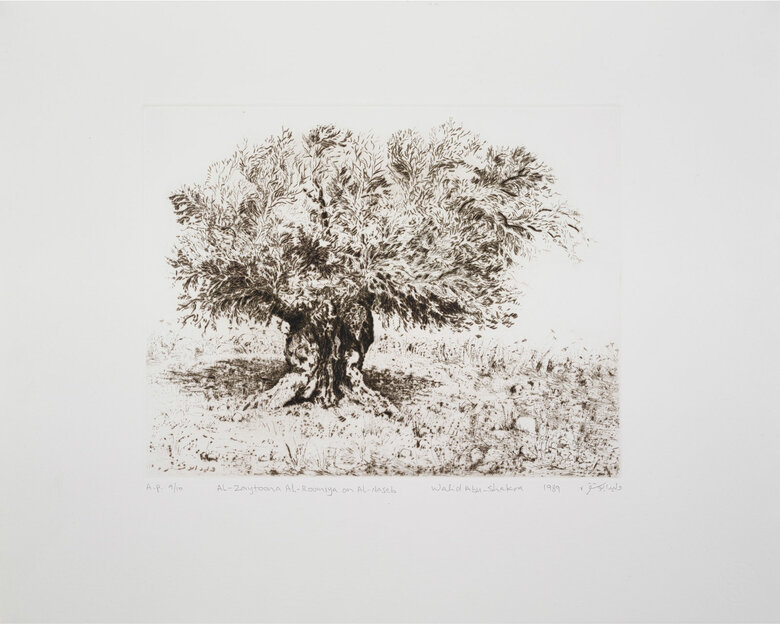


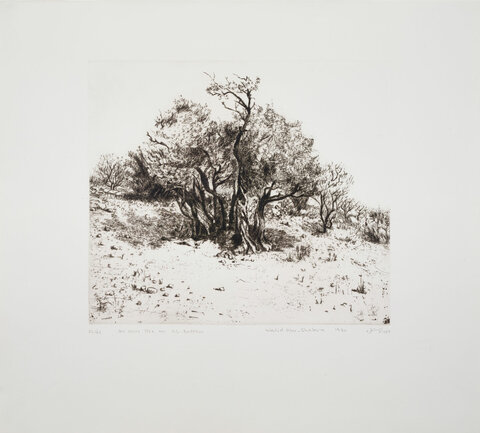
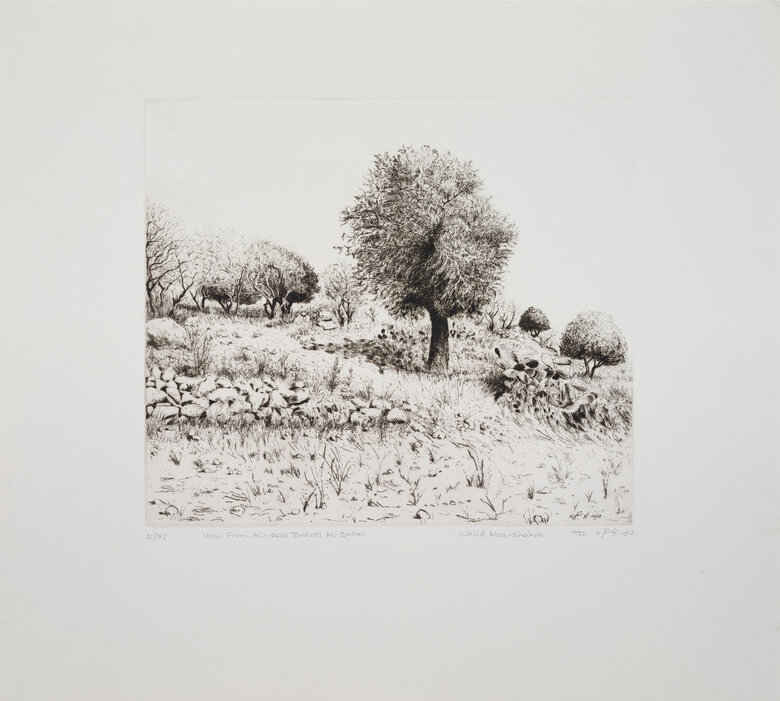

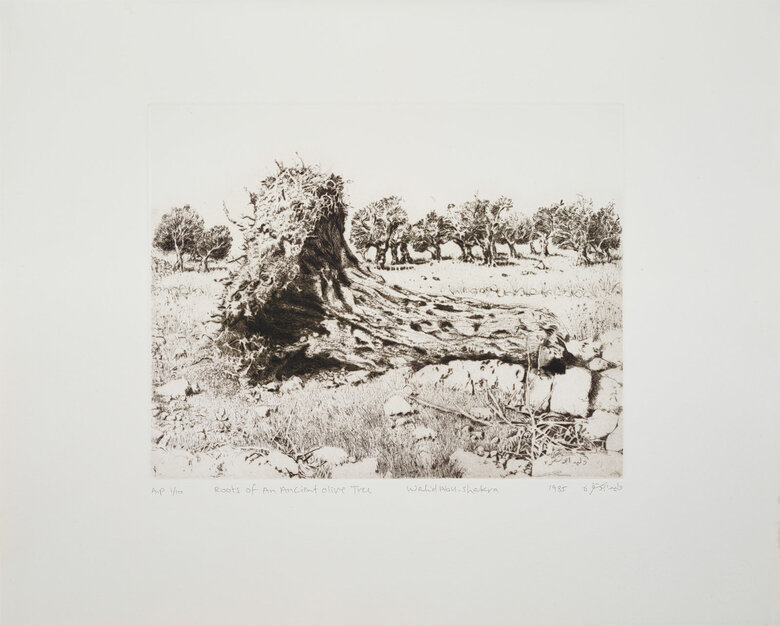

-WalidAbuShakra-Front-(1).jpg)
-WalidAbuShakra-Front-(1).jpg)
